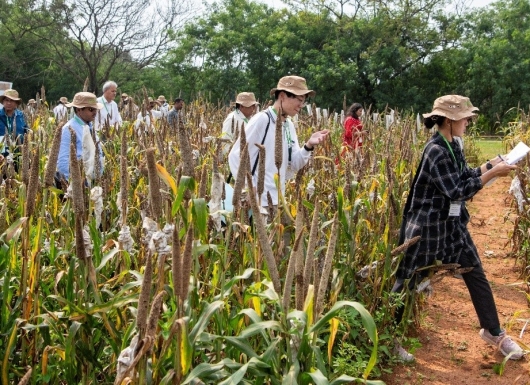Submitter: (ICRISAT)
Grain and seed storage in agriculture for self-pollinated crops is often subject to quality deterioration, resulting in significant economic losses globally. Good-quality grain and seed storage assumes significance in this context, especially in Asia and sub-Saharan Africa, where farmers primarily rely on traditional storage methods. Hermetic storage of grain and seed (especially groundnut, pigeon pea, chickpea, and millets) offers a novel, sustainable, and ecologically safe alternative to traditional methods of storing grain/seed in jute and/or polypropylene sacks.

The hermetic (airtight) storage technology has several successful examples. One of them is "PICS", which is elaborated as "Purdue Improved Crop Storage". Grains with this technology can be stored without any insect damage and fungal mold infestation for reasonably longer periods. The PICS bags are comprised of three disconnected plastic layers. The inner two layers are composed of high-density polyethylene (HDPE) material, 80 microns thick, whereas the outer third layer is a standard polypropylene woven sac. All three layers remain detached from one another and are individual, separate layers that offer sustained grain safety. Basically, the PICS technology works on the principle of creating airtight and modified atmospheric conditions (reduced oxygen and elevated carbon dioxide) in storage. Ultimately, a low-oxygen atmosphere will be created inside bags due to the respiration from already existing insects and mold fungi.
The technology has been successfully demonstrated in several West African countries on maize. There is also a huge potential to extend and scale up to other crops, such as groundnuts, legumes, and millets.
The triple-layered bags were tested in Odisha under the project ‘Scaling-up of improved groundnut varieties through established seed systems in various cropping systems of smallholder farmers in Odisha’ implemented jointly by the International Crops Research Institute for the Semi-Arid Tropics (ICRISAT) and Odisha University of Agriculture and Technology (OUAT) in partnership with the Department of Agriculture (DoA) of Odisha state. The seed storage results were encouraging. Based on the positive feedback from farmers who had used it, the proof of concept was verified in the published results in the state of Odisha.
The use of hermetic bags is a cost-effective approach. Each one costs approximately 140 INR (equivalent to USD 1.75) and can be reused for at least three seasons. The safe storage of seed using hermetic bags (i) encourages farmers to save their groundnut seed for the next planting season, thereby reducing their dependence on seed suppliers, and (ii) increases the area planted with groundnuts. A simple step, such as facilitating the safe storage of their seed, is expected to encourage farmers to cultivate groundnut, thus reviving cultivation and area coverage. It will also contribute to the increased adoption of new varieties, as seed supply will no longer be irregular, and will encourage the sharing of seeds with neighboring farmers.